Estimating Vertical Distribution of Total Suspended Matter in Coastal Waters Using Remote-Sensing Approaches
Abstract
:1. Introduction
2. Materials and Methods
2.1. Study Area
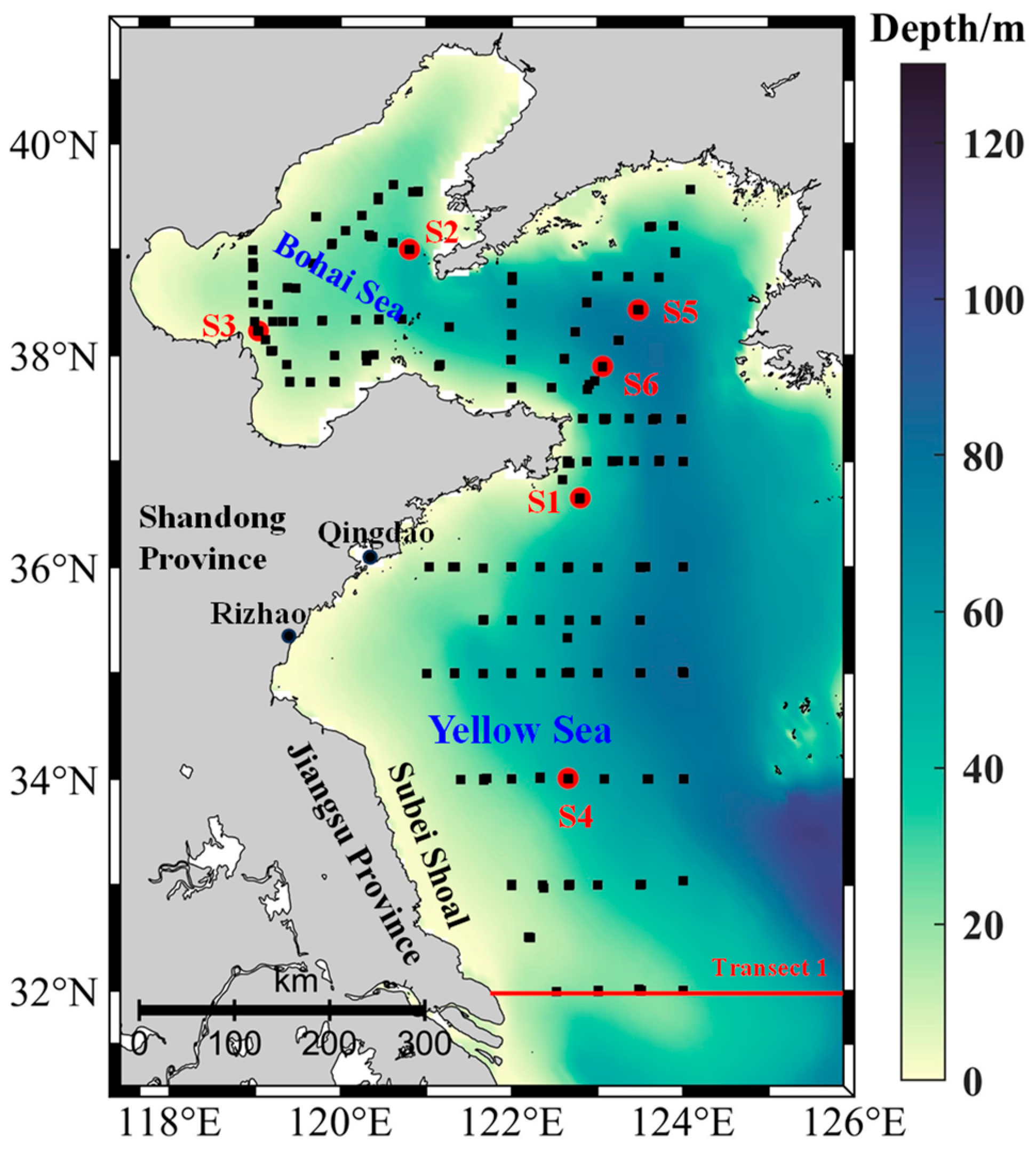
2.2. In Situ Measurements
2.3. Optical Satellite and Environmental Data
2.4. Estimation Method for TSM Vertical Distribution
2.4.1. Model for Reconstructing In Situ TSM Vertical Profile Data
2.4.2. Classification Method of TSM Vertical Profile Types
2.4.3. Estimating TSM Concentrations at Different Water Layers
2.4.4. Satellite Estimation of TSM Vertical Profile
2.5. Accuracy Assessment
3. Results
3.1. Analysis of the TSM Vertical Distribution Based on In Situ Measurements in the BSYS
3.2. Identification of TSM Vertical Profile Types

3.3. Development of the LRM-TVD Method

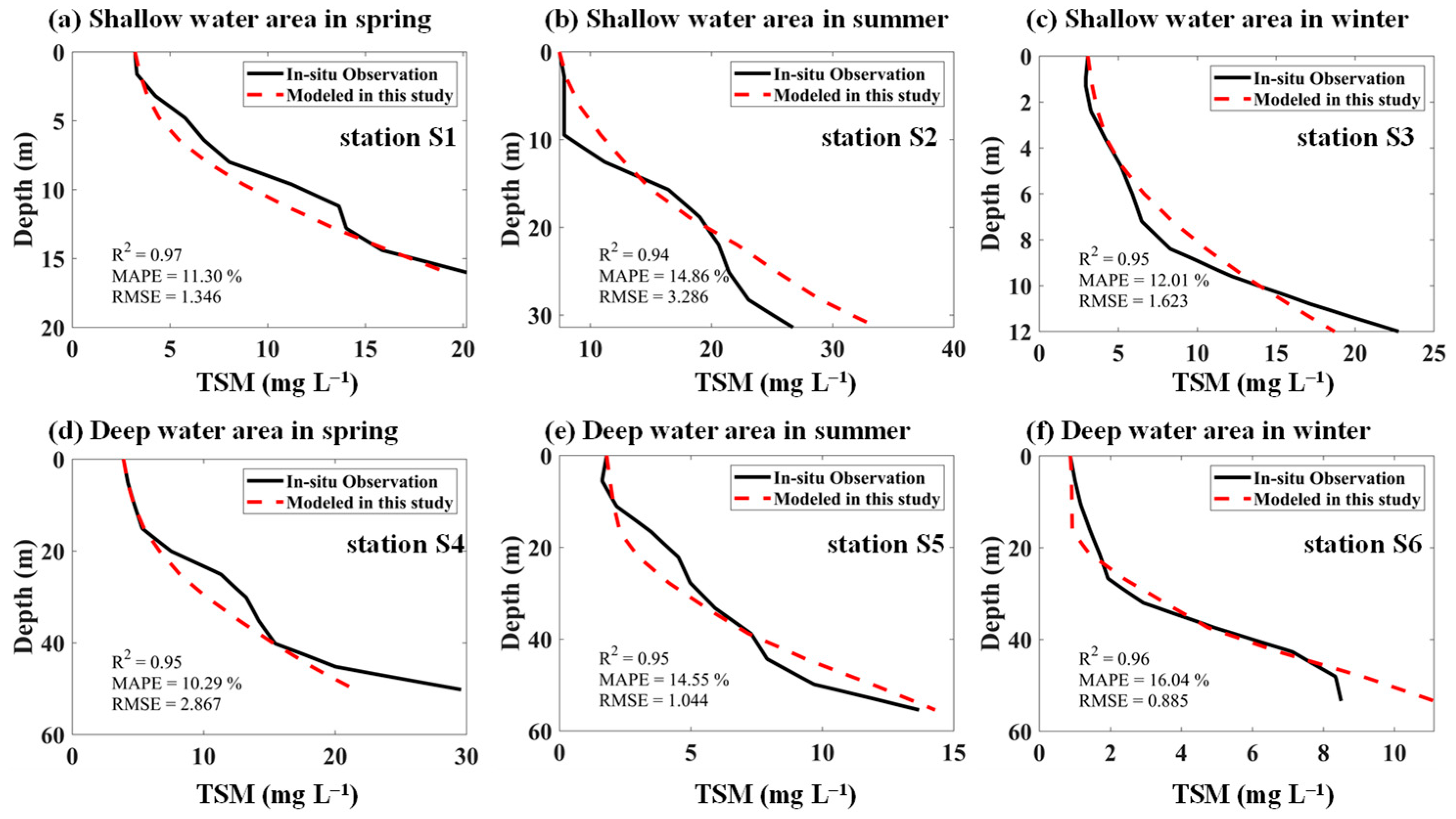
3.4. Estimating TSM Vertical Distribution for Satellite Application in the BSYS
3.4.1. Spatiotemporal Variation of TSM Vertical Type
3.4.2. Estimation of TSM Vertical Distribution from MODIS Data
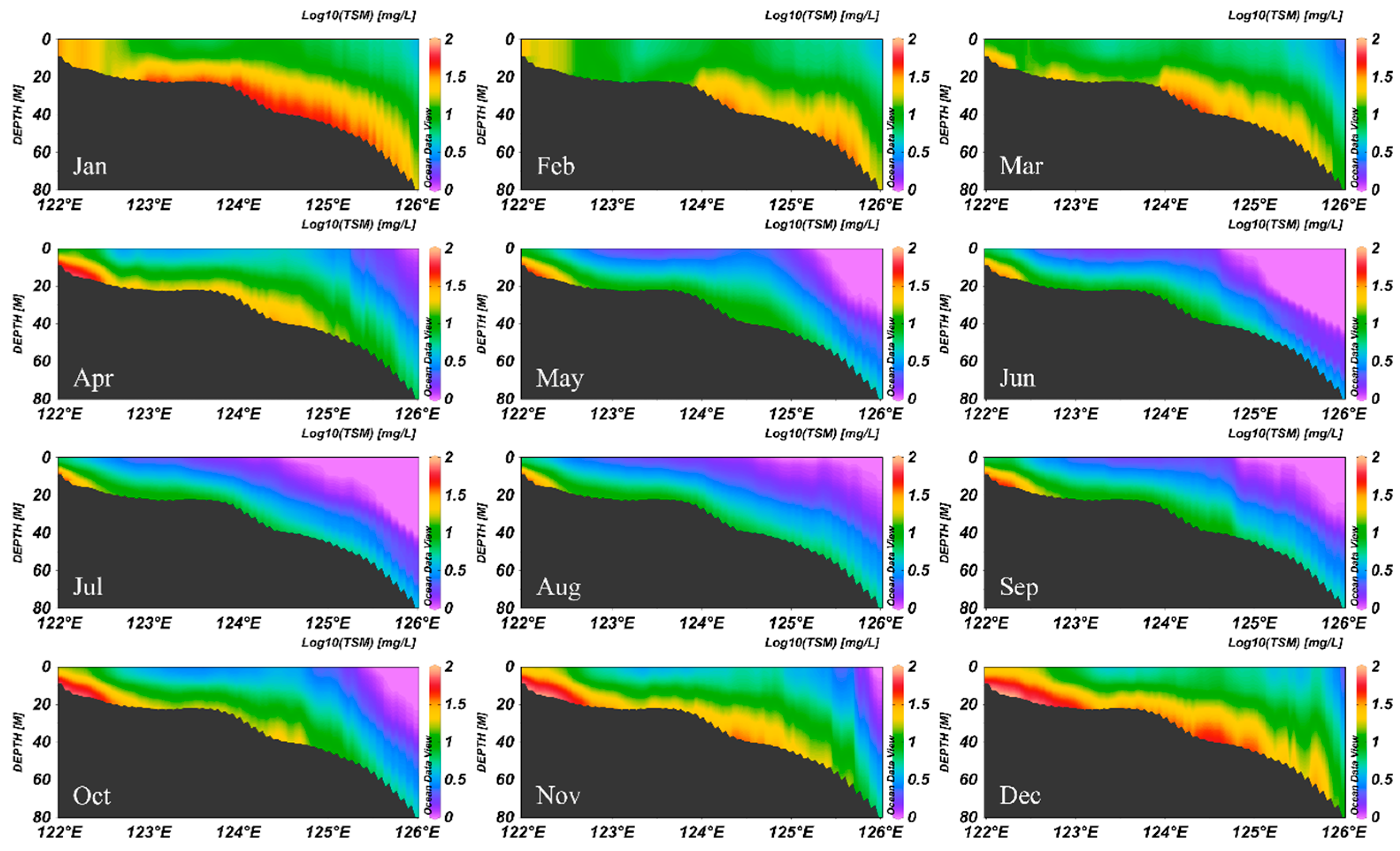
4. Discussion
4.1. Comparison with Theoretical Model
4.2. Rationality and Applicability of the Estimation Approach
4.3. Implications and Suggestions for Future Work
5. Conclusions
Author Contributions
Funding
Data Availability Statement
Acknowledgments
Conflicts of Interest
References
- Ma, M.; Feng, Z.; Guan, C.; Ma, Y.; Xu, H.; Li, H. DDT, PAH and PCB in sediments from the intertidal zone of the Bohai Sea and the Yellow Sea. Mar. Pollut. Bull. 2001, 42, 132–136. [Google Scholar] [CrossRef] [PubMed]
- Shen, X.; Huo, H.; Zhang, Y.; Zhu, Y.; Fettweis, M.; Bi, Q.; Lee, B.J.; Maa, J.P.-Y.; Chen, Q. Effects of organic matter on the aggregation of anthropogenic microplastic particles in turbulent environments. Water Res. 2023, 232, 119706. [Google Scholar] [CrossRef] [PubMed]
- Zhang, J.; Liu, S.; Xu, H.; Yu, Z.; Lai, S.; Zhang, H.; Geng, G.; Chen, J. Riverine sources and estuarine fates of particulate organic carbon from North China in late summer. Estuar. Coast. Shelf Sci. 1998, 46, 439–448. [Google Scholar] [CrossRef]
- Hou, X.; Xie, D.; Feng, L.; Shen, F.; Nienhuis, J.H. Sustained increase in suspended sediments near global river deltas over the past two decades. Nat. Commun. 2024, 15, 3319. [Google Scholar] [CrossRef]
- Tattersall, G.; Elliott, A.; Lynn, N. Suspended sediment concentrations in the Tamar estuary. Estuar. Coast. Shelf Sci. 2003, 57, 679–688. [Google Scholar] [CrossRef]
- Charantonis, A.A.; Badran, F.; Thiria, S. Retrieving the evolution of vertical profiles of Chlorophyll-a from satellite observations using Hidden Markov Models and Self-Organizing Topological Maps. Remote Sens. Environ. 2015, 163, 229–239. [Google Scholar] [CrossRef]
- Lee, Z.; Hu, C.; Shang, S.; Du, K.; Lewis, M.; Arnone, R.; Brewin, R. Penetration of UV-visible solar radiation in the global oceans: Insights from ocean color remote sensing. J. Geophys. Res. Ocean. 2013, 118, 4241–4255. [Google Scholar] [CrossRef]
- Li, P.; Yang, S.; Milliman, J.; Xu, K.; Qin, W.; Wu, C.; Chen, Y.; Shi, B. Spatial, temporal, and human-induced variations in suspended sediment concentration in the surface waters of the Yangtze Estuary and adjacent coastal areas. Estuaries Coasts 2012, 35, 1316–1327. [Google Scholar] [CrossRef]
- Schoellhamer, D.H.; Mumley, T.E.; Leatherbarrow, J.E. Suspended sediment and sediment-associated contaminants in San Francisco Bay. Environ. Res. 2007, 105, 119–131. [Google Scholar] [CrossRef]
- Zhao, L.; Song, C.; Fang, C.; Xu, Y.; Xin, Z.; Liu, Z.; Zhang, C. Spatiotemporal variation of long-term surface and vertical suspended particulate matter in the Liaohe estuary, China. Ecol. Indic. 2023, 151, 110288. [Google Scholar] [CrossRef]
- Ashall, L.M.; Mulligan, R.P.; Law, B.A. Variability in suspended sediment concentration in the Minas Basin, Bay of Fundy, and implications for changes due to tidal power extraction. Coast. Eng. 2016, 107, 102–115. [Google Scholar] [CrossRef]
- Deng, L.; Hu, S.; Chen, S.; Zeng, X.; Wang, Z.; Xu, Z.; Liu, S. Vertical distribution of suspended particulate matter and its response to river discharge and seawater intrusion: A case study in the Pearl River Estuary during the 2020 dry season. Front. Mar. Sci. 2023, 10, 1239649. [Google Scholar] [CrossRef]
- Dobrynin, M.; Gayer, G.; Pleskachevsky, A.; Günther, H. Effect of waves and currents on the dynamics and seasonal variations of suspended particulate matter in the North Sea. J. Mar. Syst. 2010, 82, 1–20. [Google Scholar] [CrossRef]
- Doxaran, D.; Ehn, J.; Bélanger, S.; Matsuoka, A.; Hooker, S.; Babin, M. Optical characterisation of suspended particles in the Mackenzie River plume (Canadian Arctic Ocean) and implications for ocean colour remote sensing. Biogeosciences 2012, 9, 3213–3229. [Google Scholar] [CrossRef]
- Leipe, T.; Loeffler, A.; Emeis, K.-C.; Jaehmlich, S.; Bahlo, R.; Ziervogel, K. Vertical patterns of suspended matter characteristics along a coastal-basin transect in the western Baltic Sea. Estuar. Coast. Shelf Sci. 2000, 51, 789–804. [Google Scholar] [CrossRef]
- Livsey, D.; Downing-Kunz, M.; Schoellhamer, D.; Manning, A. Suspended sediment flux in the San Francisco Estuary: Part I—Changes in the vertical distribution of suspended sediment and bias in estuarine sediment flux measurements. Estuaries Coasts 2020, 43, 1956–1972. [Google Scholar] [CrossRef]
- Wang, H.; Wang, A.; Bi, N.; Zeng, X.; Xiao, H. Seasonal distribution of suspended sediment in the Bohai Sea, China. Cont. Shelf Res. 2014, 90, 17–32. [Google Scholar] [CrossRef]
- Miller, R.L.; McKee, B.A. Using MODIS Terra 250 m imagery to map concentrations of total suspended matter in coastal waters. Remote Sens. Environ. 2004, 93, 259–266. [Google Scholar] [CrossRef]
- Wang, S.; Qiu, Z.; Sun, D.; Shen, X.; Zhang, H. Light beam attenuation and backscattering properties of particles in the Bohai Sea and Yellow Sea with relation to biogeochemical properties. J. Geophys. Res. Ocean. 2016, 121, 3955–3969. [Google Scholar] [CrossRef]
- Lin, J.; He, Q.; Guo, L.; van Prooijen, B.C.; Wang, Z.B. An integrated optic and acoustic (IOA) approach for measuring suspended sediment concentration in highly turbid environments. Mar. Geol. 2020, 421, 106062. [Google Scholar] [CrossRef]
- Matos, T.; Martins, M.; Henriques, R.; Goncalves, L. Design of a sensor to estimate suspended sediment transport in situ using the measurements of water velocity, suspended sediment concentration and depth. J. Environ. Manag. 2024, 365, 121660. [Google Scholar] [CrossRef] [PubMed]
- Mobley, C. Light and Water: Radiative Transfer in Natural Waters; Academic Press: San Diego, CA, USA, 1994. [Google Scholar]
- Neukermans, G.; Loisel, H.; Mériaux, X.; Astoreca, R.; McKee, D. In situ variability of mass-specific beam attenuation and backscattering of marine particles with respect to particle size, density, and composition. Limnol. Oceanogr. 2012, 57, 124–144. [Google Scholar] [CrossRef]
- Organelli, E.; Dall’Olmo, G.; Brewin, R.J.; Tarran, G.A.; Boss, E.; Bricaud, A. The open-ocean missing backscattering is in the structural complexity of particles. Nat. Commun. 2018, 9, 5439. [Google Scholar] [CrossRef]
- Babin, M.; Morel, A.; Fournier-Sicre, V.; Fell, F.; Stramski, D. Light scattering properties of marine particles in coastal and open ocean waters as related to the particle mass concentration. Limnol. Oceanogr. 2003, 48, 843–859. [Google Scholar] [CrossRef]
- Hill, P.; Boss, E.; Newgard, J.; Law, B.; Milligan, T. Observations of the sensitivity of beam attenuation to particle size in a coastal bottom boundary layer. J. Geophys. Res. Ocean. 2011, 116, C02023. [Google Scholar] [CrossRef]
- Lei, S.; Xu, J.; Li, Y.; Du, C.; Liu, G.; Zheng, Z.; Xu, Y.; Lyu, H.; Mu, M.; Miao, S. An approach for retrieval of horizontal and vertical distribution of total suspended matter concentration from GOCI data over Lake Hongze. Sci. Total Environ. 2020, 700, 134524. [Google Scholar] [CrossRef]
- Mao, Z.; Chen, J.; Pan, D.; Tao, B.; Zhu, Q. A regional remote sensing algorithm for total suspended matter in the East China Sea. Remote Sens. Environ. 2012, 124, 819–831. [Google Scholar] [CrossRef]
- Siswanto, E.; Tang, J.; Yamaguchi, H.; Ahn, Y.-H.; Ishizaka, J.; Yoo, S.; Kim, S.-W.; Kiyomoto, Y.; Yamada, K.; Chiang, C. Empirical ocean-color algorithms to retrieve chlorophyll-a, total suspended matter, and colored dissolved organic matter absorption coefficient in the Yellow and East China Seas. J. Oceanogr. 2011, 67, 627–650. [Google Scholar] [CrossRef]
- Stramski, D.; Constantin, S.; Reynolds, R.A. Adaptive optical algorithms with differentiation of water bodies based on varying composition of suspended particulate matter: A case study for estimating the particulate organic carbon concentration in the western Arctic seas. Remote Sens. Environ. 2023, 286, 113360. [Google Scholar] [CrossRef]
- Tassan, S. Local algorithms using SeaWiFS data for the retrieval of phytoplankton, pigments, suspended sediment, and yellow substance in coastal waters. Appl. Opt. 1994, 33, 2369–2378. [Google Scholar] [CrossRef]
- Yu, X.; Lee, Z.; Shen, F.; Wang, M.; Wei, J.; Jiang, L.; Shang, Z. An empirical algorithm to seamlessly retrieve the concentration of suspended particulate matter from water color across ocean to turbid river mouths. Remote Sens. Environ. 2019, 235, 111491. [Google Scholar] [CrossRef]
- Balasubramanian, S.V.; Pahlevan, N.; Smith, B.; Binding, C.; Schalles, J.; Loisel, H.; Gurlin, D.; Greb, S.; Alikas, K.; Randla, M. Robust algorithm for estimating total suspended solids (TSS) in inland and nearshore coastal waters. Remote Sens. Environ. 2020, 246, 111768. [Google Scholar] [CrossRef]
- Doxaran, D.; Froidefond, J.-M.; Castaing, P. A reflectance band ratio used to estimate suspended matter concentrations in sediment-dominated coastal waters. Int. J. Remote Sens. 2002, 23, 5079–5085. [Google Scholar] [CrossRef]
- Novoa, S.; Doxaran, D.; Ody, A.; Vanhellemont, Q.; Lafon, V.; Lubac, B.; Gernez, P. Atmospheric corrections and multi-conditional algorithm for multi-sensor remote sensing of suspended particulate matter in low-to-high turbidity levels coastal waters. Remote Sens. 2017, 9, 61. [Google Scholar] [CrossRef]
- Wei, J.; Wang, M.; Jiang, L.; Yu, X.; Mikelsons, K.; Shen, F. Global estimation of suspended particulate matter from satellite ocean color imagery. J. Geophys. Res. Ocean. 2021, 126, e2021JC017303. [Google Scholar] [CrossRef]
- Forget, P.; Broche, P.; Naudin, J.-J. Reflectance sensitivity to solid suspended sediment stratification in coastal water and inversion: A case study. Remote Sens. Environ. 2001, 77, 92–103. [Google Scholar] [CrossRef]
- Yin, X.; Yang, D.; Zhou, L. Estimation of suspended particulate matter transport via the boundary waters of the Yellow Sea and the East Sea based on satellite remote sensing. J. Trop. Oceanogr. 2018, 37, 10–16. (In Chinese) [Google Scholar]
- Brewin, R.J.; Tilstone, G.H.; Jackson, T.; Cain, T.; Miller, P.I.; Lange, P.K.; Misra, A.; Airs, R.L. Modelling size-fractionated primary production in the Atlantic Ocean from remote sensing. Prog. Oceanogr. 2017, 158, 130–149. [Google Scholar] [CrossRef]
- Puissant, A.; El Hourany, R.; Charantonis, A.A.; Bowler, C.; Thiria, S. Inversion of phytoplankton pigment vertical profiles from satellite data using machine learning. Remote Sens. 2021, 13, 1445. [Google Scholar] [CrossRef]
- Siswanto, E.; Ishizaka, J.; Yokouchi, K. Estimating chlorophyll-a vertical profiles from satellite data and the implication for primary production in the Kuroshio front of the East China Sea. J. Oceanogr. 2005, 61, 575–589. [Google Scholar] [CrossRef]
- Xue, K.; Zhang, Y.; Duan, H.; Ma, R.; Loiselle, S.; Zhang, M. A remote sensing approach to estimate vertical profile classes of phytoplankton in a eutrophic lake. Remote Sens. 2015, 7, 14403–14427. [Google Scholar] [CrossRef]
- Morel, A.; Prieur, L. Analysis of variations in ocean color. Limnol. Oceanogr. 1977, 22, 709–722. [Google Scholar] [CrossRef]
- Kass, G.V. An exploratory technique for investigating large quantities of categorical data. J. Roy. Stat. Soc. Ser. C. (Appl. Stat.) 1980, 29, 119–127. [Google Scholar] [CrossRef]
- Biggs, D.; De Ville, B.; Suen, E. A method of choosing multiway partitions for classification and decision trees. J. Appl. Stat. 1991, 18, 49–62. [Google Scholar] [CrossRef]
- Congalton, R.G. A review of assessing the accuracy of classifications of remotely sensed data. Remote Sens. Environ. 1991, 37, 35–46. [Google Scholar] [CrossRef]
- Zhang, H.; Liu, J.; Ye, X.; Bai, Y.; Sun, D.; Wang, S.; Dong, J. Detecting Sargassum bloom directly from satellite top-of-atmosphere reflectance with high-resolution images. IEEE Trans. Geosci. Remote Sens. 2023, 61, 1–12. [Google Scholar] [CrossRef]
- Burchard, H.; Schuttelaars, H.M.; Ralston, D.K. Sediment trapping in estuaries. Annu. Rev. Mar. Sci. 2018, 10, 371–395. [Google Scholar] [CrossRef]
- Rouse, H. Experiments on the Mechanics of Sediment Suspension. In Proceedings of the Fifth International Congress for Applied Mechanics, Cambridge, MA, USA, 12–16 September 1938; Wiley: New York, NY, USA, 1938. [Google Scholar]
- Bi, N.; Yang, Z.; Wang, H.; Fan, D.; Sun, X.; Lei, K. Seasonal variation of suspended-sediment transport through the southern Bohai Strait. Estuar. Coast. Shelf Sci. 2011, 93, 239–247. [Google Scholar] [CrossRef]
- Deser, C.; Alexander, M.A.; Xie, S.-P.; Phillips, A.S. Sea surface temperature variability: Patterns and mechanisms. Annu. Rev. Mar. Sci. 2010, 2, 115–143. [Google Scholar] [CrossRef]
- Levitus, S.; Antonov, J.I.; Boyer, T.P.; Stephens, C. Warming of the world ocean. Science 2000, 287, 2225–2229. [Google Scholar] [CrossRef]
- Weihs, R.R.; Bourassa, M.A. Modeled diurnally varying sea surface temperatures and their influence on surface heat fluxes. J. Geophys. Res. Ocean. 2014, 119, 4101–4123. [Google Scholar] [CrossRef]
- Gordon, H.R.; Brown, O.B.; Jacobs, M.M. Computed relationships between the inherent and apparent optical properties of a flat homogeneous ocean. Appl. Opt. 1975, 14, 417–427. [Google Scholar] [CrossRef] [PubMed]
- Xiao, Y.; Wu, Z.; Cai, H.; Tang, H. Suspended sediment dynamics in a well-mixed estuary: The role of high suspended sediment concentration (SSC) from the adjacent sea area. Estuar. Coast. Shelf Sci. 2018, 209, 191–204. [Google Scholar] [CrossRef]
- Simpson, J.H.; Sharples, J. Introduction to the Physical and Biological Oceanography of Shelf Seas; Cambridge University Press: Cambridge, UK, 2012. [Google Scholar]
- Li, J.; Zhang, C. Sediment resuspension and implications for turbidity maximum in the Changjiang Estuary. Mar. Geol. 1998, 148, 117–124. [Google Scholar] [CrossRef]
- Bian, C.; Jiang, W.; Greatbatch, R.J. An exploratory model study of sediment transport sources and deposits in the Bohai Sea, Yellow Sea, and East China Sea. J. Geophys. Res. Ocean. 2013, 118, 5908–5923. [Google Scholar] [CrossRef]
- Fettweis, M.; Van den Eynde, D. The mud deposits and the high turbidity in the Belgian–Dutch coastal zone, southern bight of the North Sea. Cont. Shelf Res. 2003, 23, 669–691. [Google Scholar] [CrossRef]
- Liang, M.; Liu, J.; Lin, Y.; He, Z.; Wei, W.; Jia, L. Typhoon-induced suspended sediment dynamics in the mouth-bar region of a river/wave-dominated estuary. Mar. Geol. 2023, 456, 106972. [Google Scholar] [CrossRef]
- Yang, H.; Yang, S.; Xu, K. River-sea transitions of sediment dynamics: A case study of the tide-impacted Yangtze River estuary. Estuar. Coast. Shelf Sci. 2017, 196, 207–216. [Google Scholar] [CrossRef]
- Gargett, A.E. Vertical eddy diffusivity in the ocean interior. J. Mar. Res. 1984, 42, 359–393. [Google Scholar] [CrossRef]
- Hales, B.; Takahashi, T.; Bandstra, L. Atmospheric CO2 uptake by a coastal upwelling system. Glob. Biogeochem. Cycles 2005, 19, GB1009. [Google Scholar] [CrossRef]
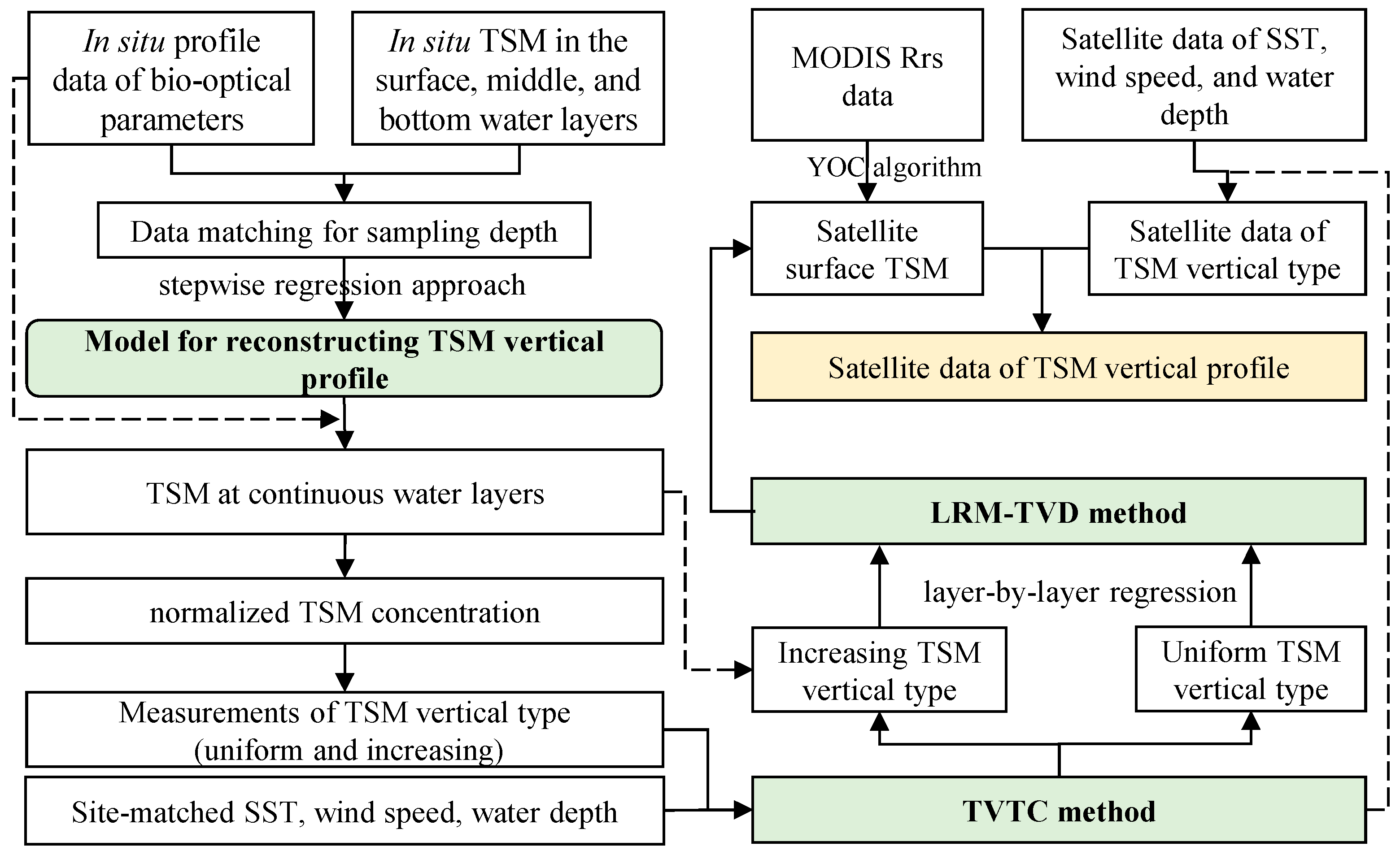
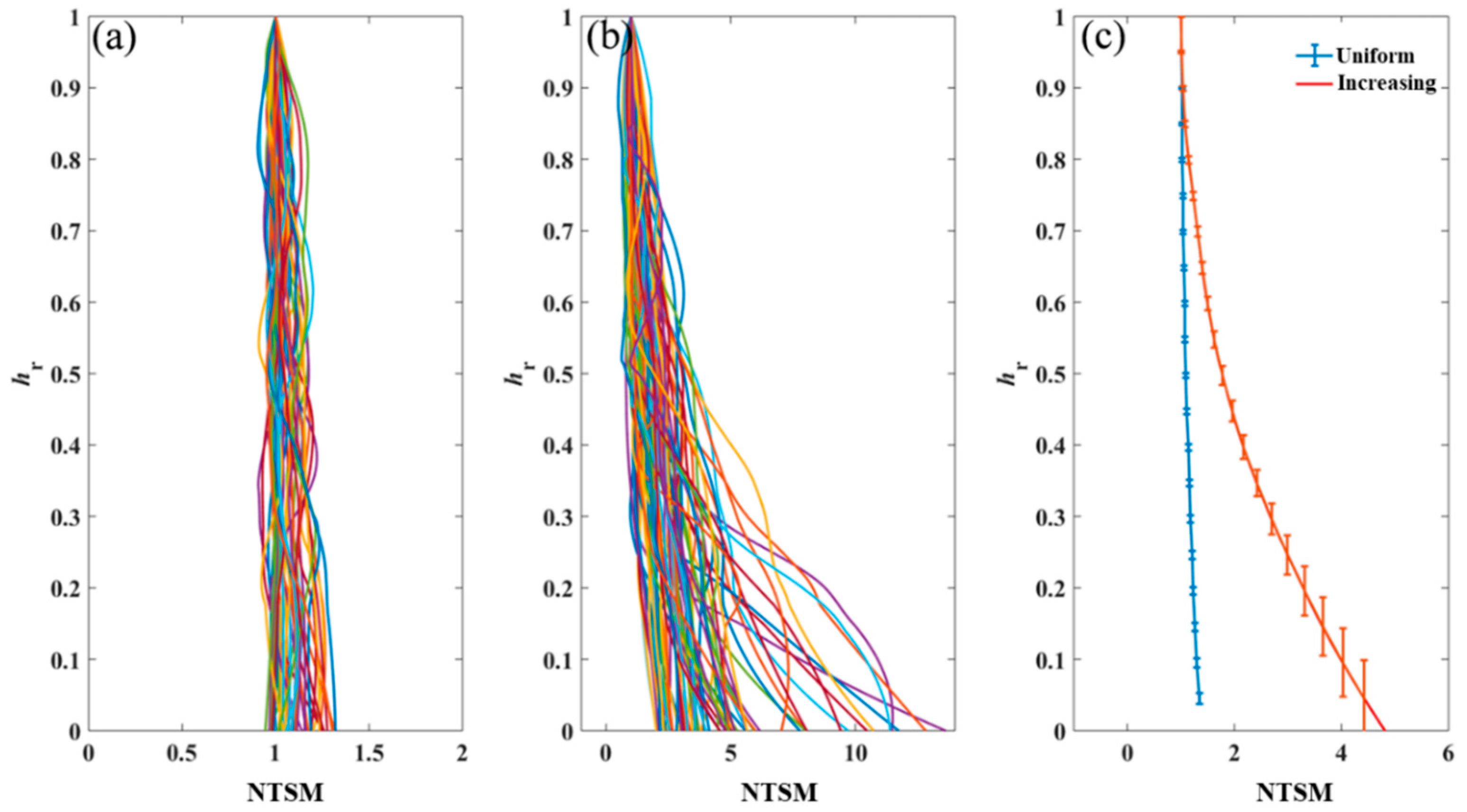
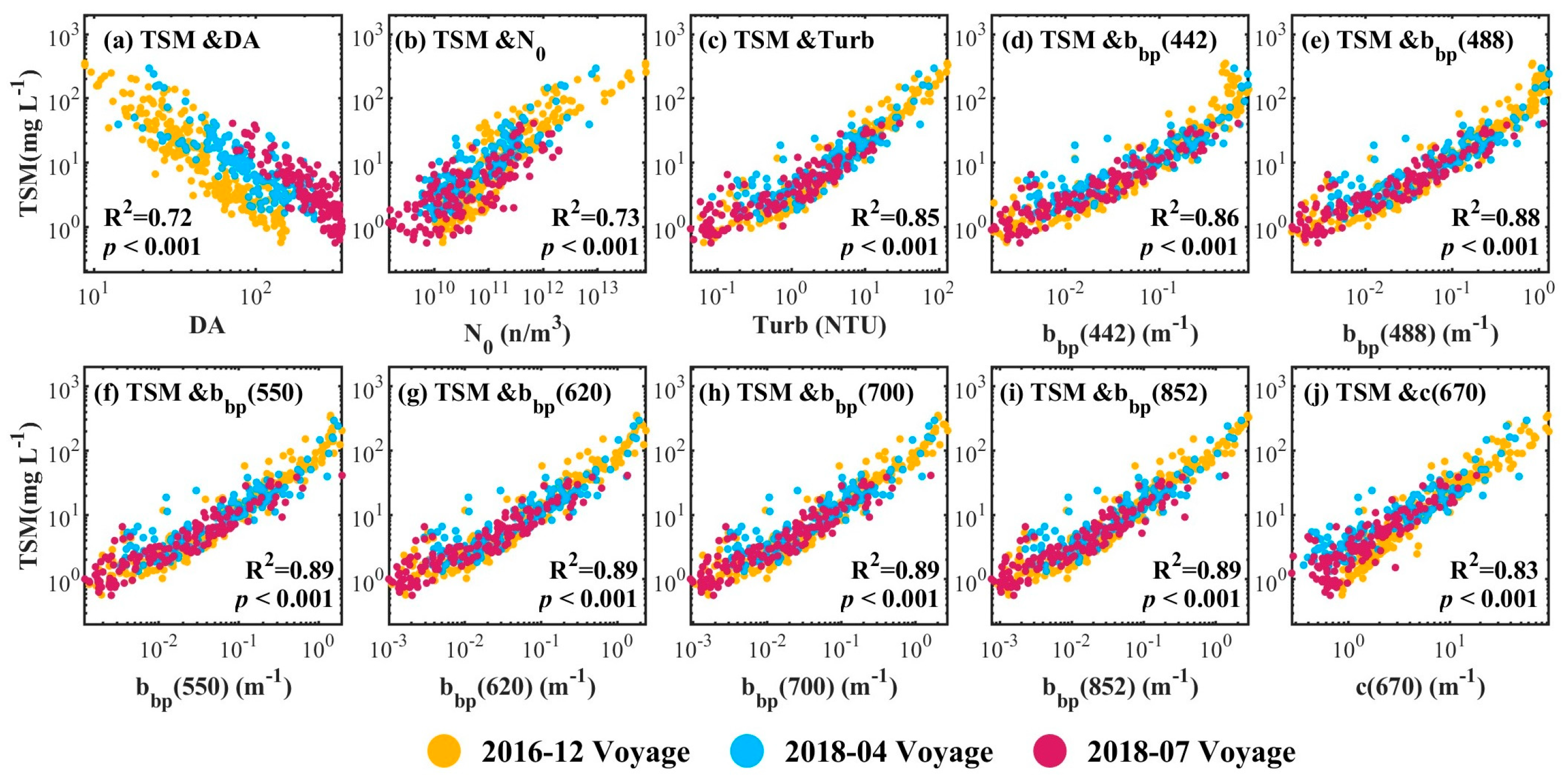
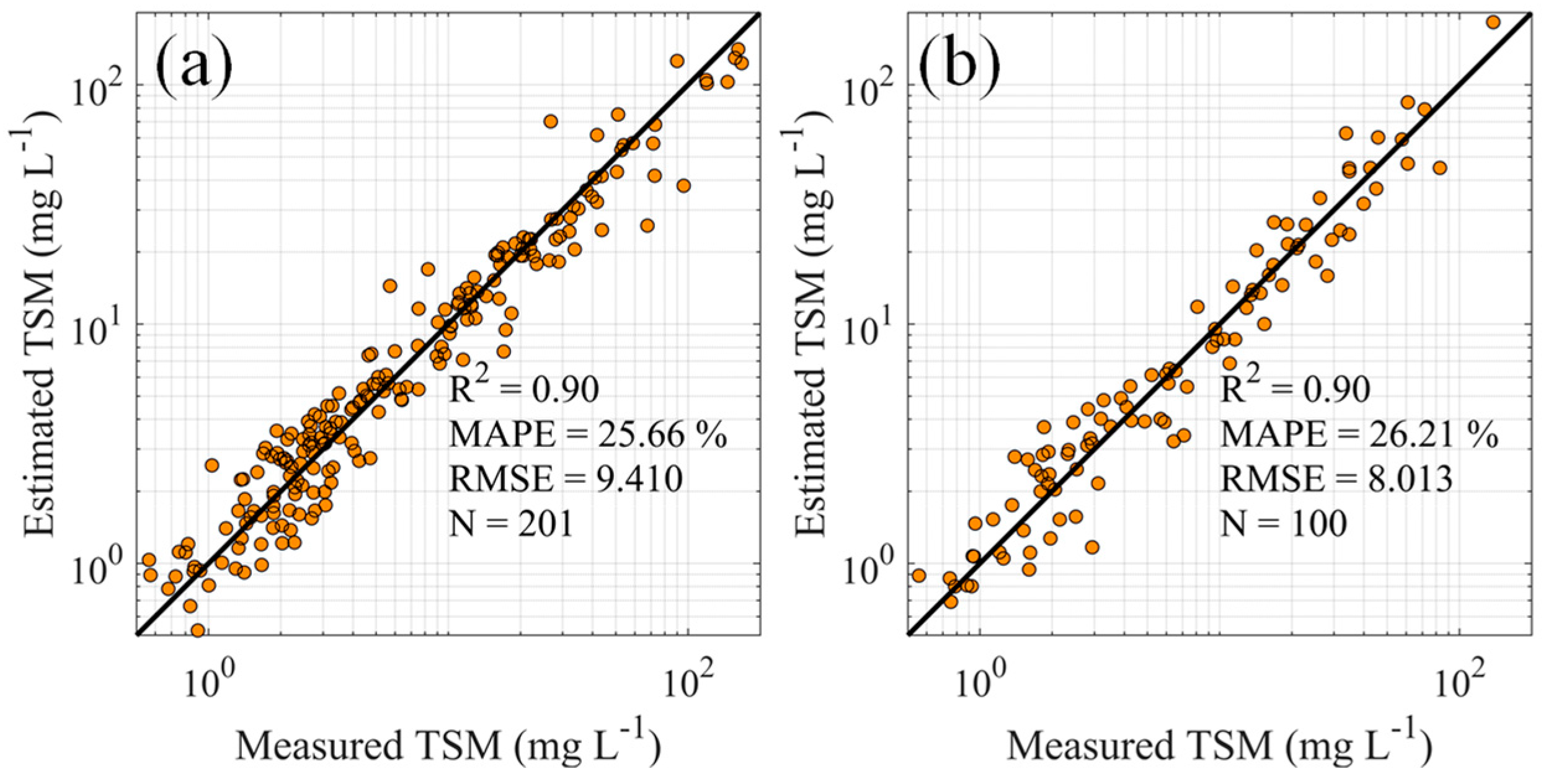


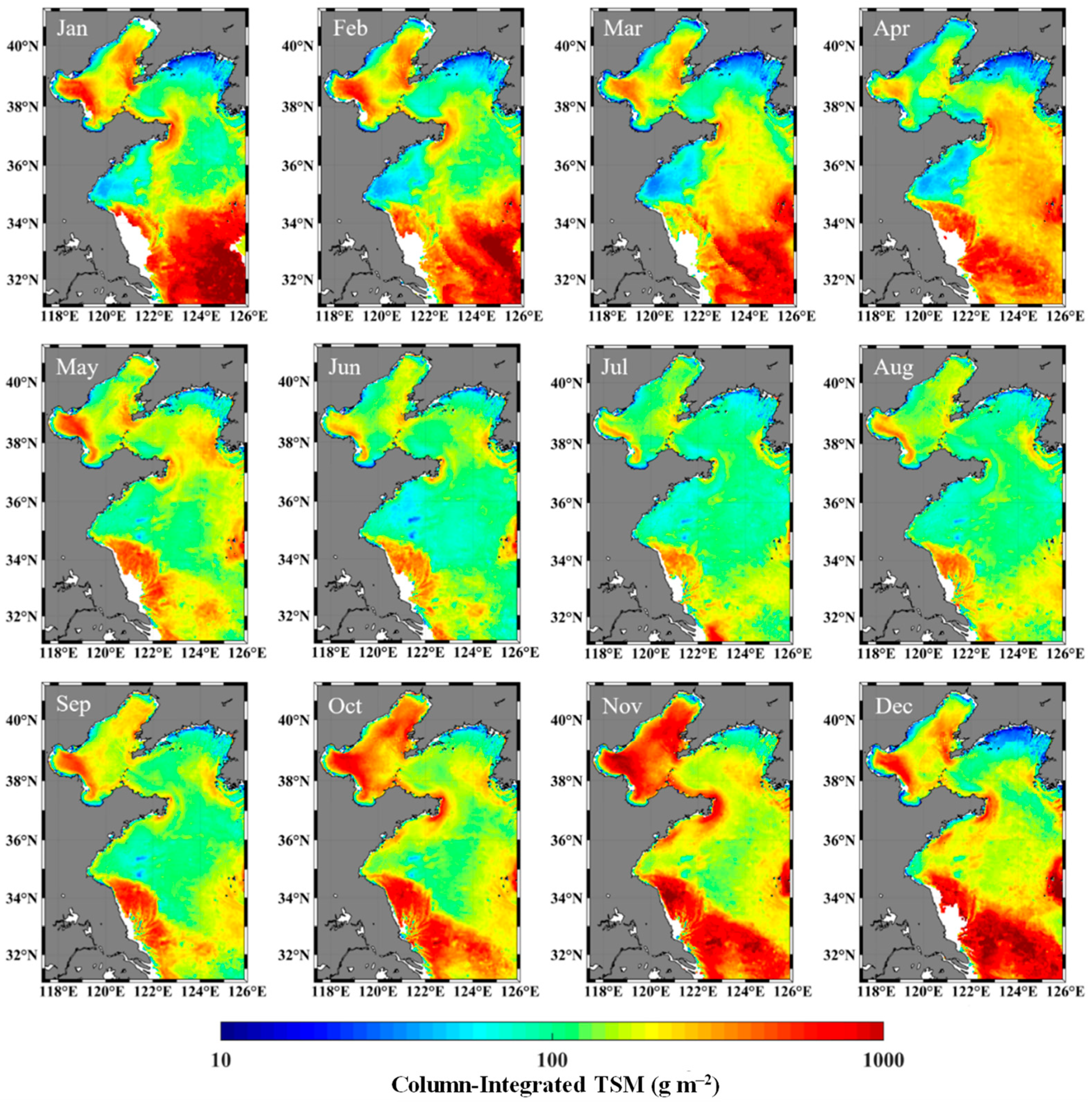
| Parameter | a0 | DA | N0 | Turb | bbp (442) | bbp (488) |
|---|---|---|---|---|---|---|
| Coefficient | 3.104 | 0.065 | −0.026 | −0.671 | 0.027 | −1.305 |
| Parameter | bbp (5 50) | bbp (620) | bb p(700) | bbp (852) | C (670) | |
| Coefficient | 1.208 | 0.584 | 1.083 | −0.263 | 0.067 |
| Type | Method-Detected Type | Precision (%) | Dataset | ||
|---|---|---|---|---|---|
| Uniform | Increasing | ||||
| Field-measured type | uniform | 51 | 9 | 85.0% | Training |
| increasing | 15 | 81 | 84.3% | ||
| uniform | 22 | 4 | 84.6% | Testing | |
| increasing | 7 | 34 | 82.9% | ||
| Parameter | Depth | Wind Speed | SST | SSS | TSMsurf |
|---|---|---|---|---|---|
| a | 0.015 | 0.000 | 0.022 | 0.000 | 0.001 |
| b | 0.055 | 0.015 | 0.004 | 0.004 | 0.000 |
Disclaimer/Publisher’s Note: The statements, opinions and data contained in all publications are solely those of the individual author(s) and contributor(s) and not of MDPI and/or the editor(s). MDPI and/or the editor(s) disclaim responsibility for any injury to people or property resulting from any ideas, methods, instructions or products referred to in the content. |
© 2024 by the authors. Licensee MDPI, Basel, Switzerland. This article is an open access article distributed under the terms and conditions of the Creative Commons Attribution (CC BY) license (https://creativecommons.org/licenses/by/4.0/).
Share and Cite
Zhang, H.; Ren, X.; Wang, S.; Li, X.; Sun, D.; Wang, L. Estimating Vertical Distribution of Total Suspended Matter in Coastal Waters Using Remote-Sensing Approaches. Remote Sens. 2024, 16, 3736. https://doi.org/10.3390/rs16193736
Zhang H, Ren X, Wang S, Li X, Sun D, Wang L. Estimating Vertical Distribution of Total Suspended Matter in Coastal Waters Using Remote-Sensing Approaches. Remote Sensing. 2024; 16(19):3736. https://doi.org/10.3390/rs16193736
Chicago/Turabian StyleZhang, Hailong, Xin Ren, Shengqiang Wang, Xiaofan Li, Deyong Sun, and Lulu Wang. 2024. "Estimating Vertical Distribution of Total Suspended Matter in Coastal Waters Using Remote-Sensing Approaches" Remote Sensing 16, no. 19: 3736. https://doi.org/10.3390/rs16193736





